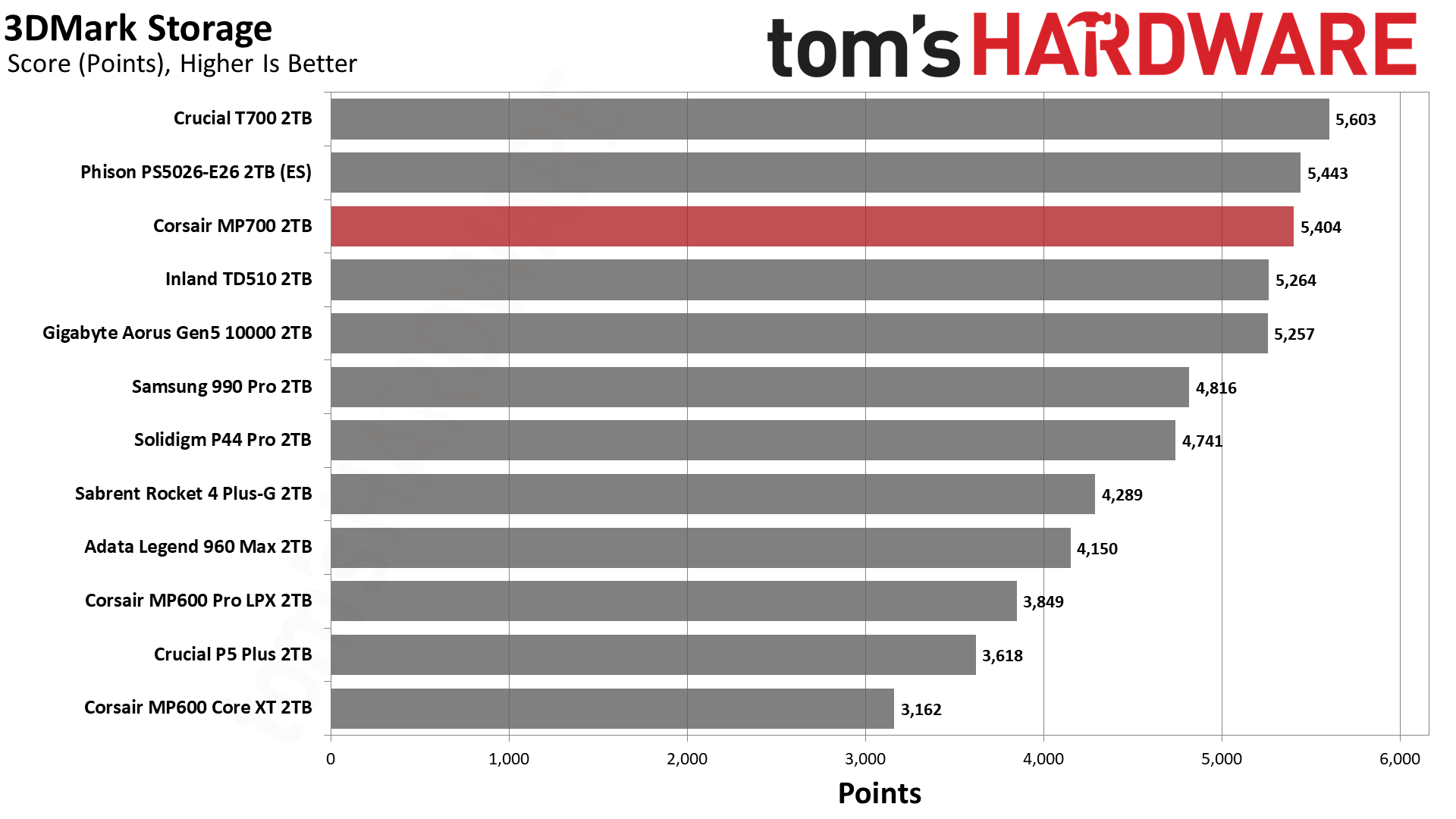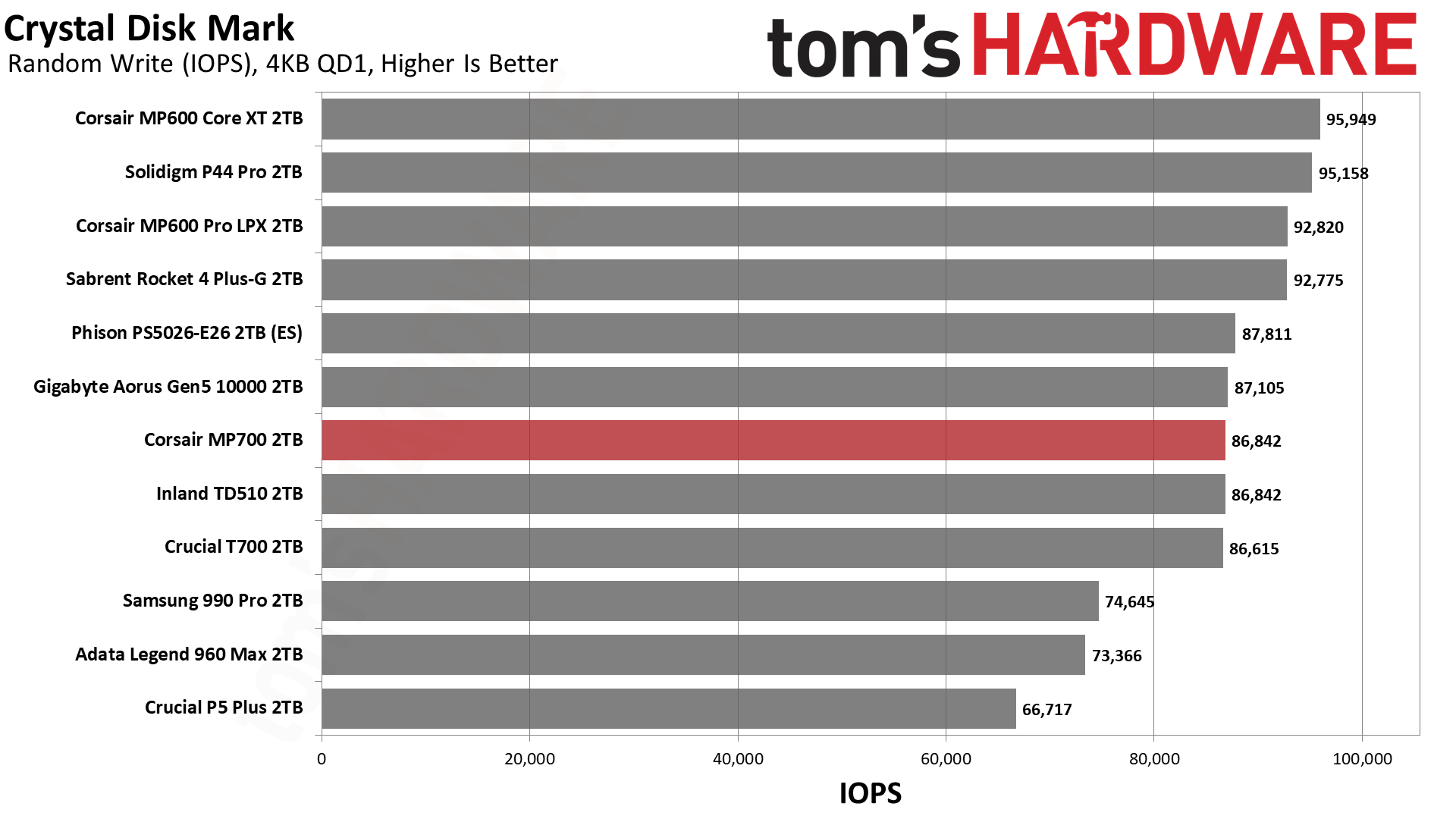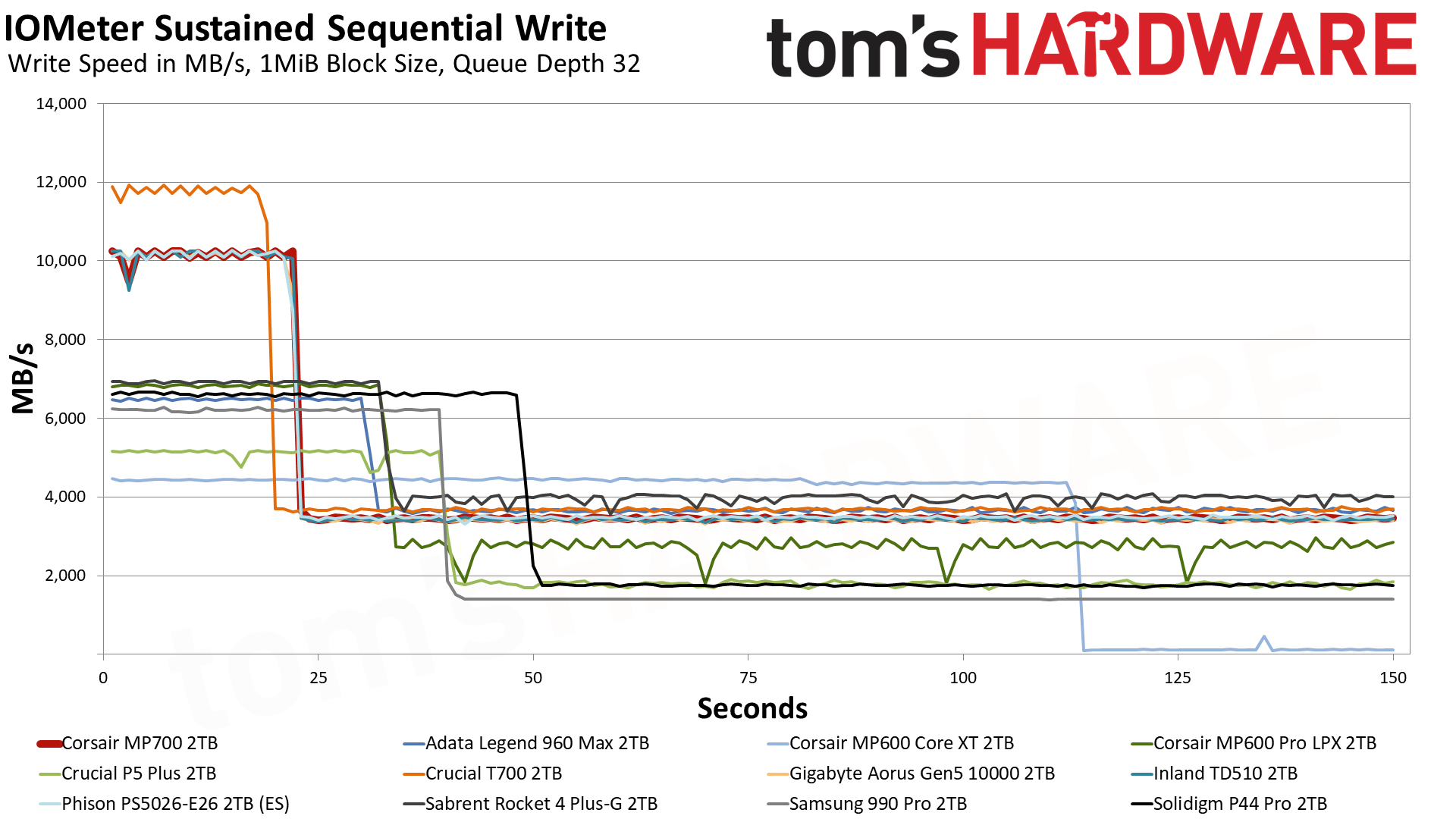Why you can trust Tom's Hardware
Comparison Products
We're bringing out the fastest SSDs we have in our lab to compare to the MP700, and that includes a few models we haven't yet reviewed. We included several PCIe 5.0 drives, like the Phison E26 Preview SSD as well as the Gigabyte Aorus Gen5 100000, Inland TD510, and Crucial T700 preview. The Corsair MP600 Core XT (which is also launching today) is also in the mix — it's a completely different level of performance and price.
Naturally, we're also comparing the Corsair MP700 to some of the best PCIe 4.0 SSDs we've tested. These include the Samsung 990 Pro, the Solidigm P44 Pro, the Sabrent Rocket 4 Plus-G, the Adata Legend 960, the Corsair MP600 Pro LPX, and the Crucial P5 Plus.
Trace Testing - 3DMark Storage Benchmark
Built for gamers, 3DMark’s Storage Benchmark focuses on real-world gaming performance. Each round in this benchmark stresses storage based on gaming activities including loading games, saving progress, installing game files, and recording gameplay video streams.



The MP700 is tied for the fastest retail-available drive we’ve ever tested in 3DMark, although the T700 we previewed is faster yet (the T700 firmware isn't final yet).
The MP700 matches the Phison E26 ES and beats all of the PCIe 4.0 drives handily, although the Samsung 990 Pro and P44 Pro are strong contenders.
Trace Testing – PCMark 10 Storage Benchmark
PCMark 10 is a trace-based benchmark that uses a wide-ranging set of real-world traces from popular applications and everyday tasks to measure the performance of storage devices.



The MP700 is again near the top of our rankings, this time in PCMark 10. Again, the 990 Pro and P44 Pro are the best PCIe 4.0 SSDs.
Synthetic Testing - ATTO / CrystalDiskMark
ATTO and CrystalDiskMark (CDM) are free and easy-to-use storage benchmarking tools that SSD vendors commonly use to assign performance specifications to their products. Both of these tools give us insight into how each device handles different file sizes.










The MP700 does exceptionally well in ATTO and has smoothed out the anomaly we saw with the Phison E26 ES during sequential write workloads. The CrystalDiskMark sequential performance for the MP700 matches the ES and, as expected, it easily beats all of the PCIe 4.0 drives.
Get Tom's Hardware's best news and in-depth reviews, straight to your inbox.
Random 4KB read latency is excellent, but not as good as the 990 Pro. Samsung’s flash is quite good here, although compromises might have to be made with its next generation if string-stacking is required. The MP700 also has good random 4KB write latency, but it’s not the best. The peak IOPS at high queue depths are also impressive, but not the highest.
Sustained Write Performance and Cache Recovery
Official write specifications are only part of the performance picture. Most SSDs implement a write cache, which is a fast area of (usually) pseudo-SLC programmed flash that absorbs incoming data. Sustained write speeds can suffer tremendously once the workload spills outside of the cache and into the "native" TLC or QLC flash.
We use Iometer to hammer the SSD with sequential writes for over 15 minutes to measure both the size of the write cache and performance after the cache is saturated. We also monitor cache recovery via multiple idle rounds.



The 2TB MP700 writes in pSLC cache at up to 10.2 GBps for almost 22 seconds, showing it has a comfortable cache capacity of about 220 GB. This allows the drive to maintain a relatively high TLC write speed of 3.5 GBps. The Rocket 4 Plus-G demonstrates what can be done with a smallish cache and enough dies. The denser flash on the MP700 has 50% more planes, but there are also half as many die with which to interleave. There’s more performance to get out of this flash and the E26, as we see with the T700.
Eventually, despite the fast flash and small cache, a folding state is reached but writes still stay at up to 1.5 GBps. Recovery to TLC speeds are rapid, with good steady-state write performance of around 3.5 GBps.
Power Consumption
We use the Quarch HD Programmable Power Module to gain a deeper understanding of power characteristics. Idle power consumption is an important aspect to consider, especially if you're looking for a laptop upgrade as even the best ultrabooks can have mediocre storage.
Some SSDs can consume watts of power at idle while better-suited ones sip just milliwatts. Average workload power consumption and max consumption are two other aspects of power consumption, but performance-per-watt is more important. A drive might consume more power during any given workload, but accomplishing a task faster allows the drive to drop into an idle state more quickly, ultimately saving energy.




When we previewed the Phison E26, we were disappointed with its poor power efficiency. We figured this was one area that could see some improvement. The MP700 shows that this was not the case as it is equally underwhelming. Critics might say the idle power pull is overblown since ASPM/LPM is disabled, but this kind of drive won’t find its way naked into a laptop. There is work to be done here and we will see improvements with four-channel controllers and 7nm designs.
We are in the process of reworking how we manage temperature testing as current and future drives, starting with PCIe 5.0, are potentially more complex in this regard. Heatsinks are becoming more substantial in size and can even use active cooling. Motherboards are coming with more elaborate heatsinks for M.2 drives, too. Bare drives only make sense if purchased to add a heatsink of this or another type. Throttling impacts performance. Therefore, testing must be adjusted to account for this future.
The MP700, for its part, is designed to thermal throttle beginning at 76C, scaling thereafter. We did not see any throttling during testing with our solution, though we're using a large and well-ventilated case coupled with a large heatsink from the motherboard. A compact mini-ITX case might struggle more to keep thermals in check, depending on other components.
Test Bench and Testing Notes
| CPU | Intel Core i9-12900K |
| Motherboard | Asus ROG Maximus Z790 Hero |
| Memory | 2x16GB G.Skill DDR5-5600 CL28 |
| Graphics | Intel Iris Xe UHD Graphics 770 |
| CPU Cooling | Enermax Aquafusion 240 |
| Case | Cooler Master TD500 Mesh V2 |
| Power Supply | Cooler Master V850 i Gold |
| OS Storage | Sabrent Rocket 4 Plus-G 2TB |
| Operating System | Windows 11 Pro |
We use an Alder Lake platform with most background applications such as indexing, Windows updates, and anti-virus disabled in the OS to reduce run-to-run variability. Each SSD is prefilled to 50% capacity and tested as a secondary device. Unless noted, we use active cooling for all SSDs.
Bottom Line
The Corsair MP700 is the first PCIe 5.0 SSD we’ve officially reviewed, though it's similar in most respects to the Phison E26 preview ES. As you can see, we've also put several other PCIe 5.0 SSDs through our test suite to give you a taste of its relative performance against other competing drives.
The MP700 matched or exceeded the Phison ES, Inland TD510, and Aorus Gen 5 100000 with no real surprises, providing the fastest sequential performance possible. The MP700's overall performance and consistency were also quite good, and the heatsink on our motherboard was sufficient to keep the drive cool. That said, the MP700 is a power-hungry beast for the desktop user who wants the most horsepower, so you'll need to ensure you have a proper motherboard M.2 heatsink or purchase a capable cooler at retail.
It's noteworthy that Corsair has a solid reputation for offering good support and has a long track record in the SSD market, which could be an important factor as other manufacturers release similar drives.
These initial PCIe 5.0 drives require a compliant motherboard to reach peak performance, so they're confined to the newest systems on the market. We haven't yet seen the maximum attainable performance over PCIe 4.0 SSDs. Faster flash, and thus faster drives, are on the horizon. For instance, we recently posted a preview of the Crucial T700 SSD that reaches higher peak sequential performance than the MP700. We conducted the T700 tests with firmware that wasn't final, so there might be a few changes with the final production-ready drives.
SSD prices have been coming down rapidly, so the premium for PCIe 5.0 SSDs also needs to be reduced. This will happen as more of these drives come out, particularly as faster drives built on the Phison E26 controller are already on the horizon. Optional features and DirectStorage optimization are still nice to have, but the initial crop of PCIe 5.0 SSDs still feel like early adopter products. There’s not enough of a leap over still very fast, much cheaper PCIe 4.0 drives to justify the pricing premiums we've seen — at least not for now. In the meantime, the Corsair MP700 is a solid entrant that delivers leading-edge performance that you can find at retailers today.
Updated Bottom Line
Phison saw a problem with its product and decided to come up with a somewhat unique approach to fix it. In this, they were successful, as the drive did not quit on us, and its steady state performance is relatively high for a massively throttling device. It’s clear that the SSD is not meant to be run without additional cooling - as every manufacturer is making clear on the box, on their site, in the manual, etc. - but it’s good to know there is a failsafe. It’s still possible to make the drive shut off if it’s artificially overheated, but with proper use, that should not be a problem. Further, even if the drive does hit a throttling state it should be able to maintain reasonable levels of performance if such a condition is mild or temporary.
On the other hand, there are other improvements we would like to see, such as improved energy efficiency and especially lower power consumption when the drive is idle. We test idle in desktop or performance conditions, but the power draw is still way too high. Additionally, Phison has hyped up its throttling solution when these drives run unquestionably hot. Phison’s approach is also not entirely novel and could use further refinement. It gets the job done, and we do recommend updating your drive’s firmware, but there’s still room for improvement.
More generally, there has been a lot of concern about the power draw and heat output of high-end SSDs. 7nm controllers and more efficient flash will help this situation a lot, especially when bandwidth can be provided by DRAM-less, four-channel solutions. If we look at PCIe 4.0 drives like the Lexar NM790 and Addlink A93 we see what can be achieved. SSD manufacturers are improving their heatsink designs, and motherboard manufacturers are designing their boards for high-end SSDs, in part with assistance from Phison. Even the M.2 spec is seeing some possible changes, so these issues can be addressed.
Even if there will always be super-fast, cutting-edge drives, throttling improvements are being developed simultaneously. We’ve seen this on the WD Black SN850X, the Samsung 990 Pro, and many other drives with adaptive thermal management. DirectStorage workloads will also require improvements to sustained performance which will necessitate better drive management. For the time being, Phison’s solution is satisfactory for the enthusiast who wants maximum bandwidth, but there’s more to come.
In the short term, it is recommended to stay on top of developments such as this firmware-based solution. Unfortunately, not all SSD vendors that use Phison's controller have released this new firmware yet, but we can expect to see them release new variants over time. In the meantime, maintain your SSD and keep it cool, both with a heatsink and by using a ventilated case. Avoid high-end drives where they aren’t necessary. Choose a drive based on your needs rather than what’s reported as being the fastest. There are plenty of drives out there that won’t break the bank or overheat. The SSD market is wide, and prices are low, so be sure to shop around and keep an eye on our reviews to determine which drive is right for you.
MORE: Best SSDs
MORE: Best External SSDs and Hard Drives
MORE: How We Test HDDs And SSDs
MORE: All SSD Content
Current page: 2TB Performance Results and Updated Bottom Line
Prev Page Updated 2TB Performance Results
Shane Downing is a Freelance Reviewer for Tom’s Hardware US, covering consumer storage hardware.
-
emike09 Heat sink requirements on NVMe was bad enough, now we have an active fan and a SATA power cable to connect to it? Ugh. I'll stick to passive cooling. I don't need PCI-e 5 speeds, give me more capacity please! Where are affordable 4TB and 8TB drives? PCI-e 4.0 speeds are quite sufficient. I'm still running on PCI-e 3 drives and quite satisfied with professional apps and games load times.Reply -
Colif Reply
seems bot can't even link right articlemontss said:review link is broken
https://www.tomshardware.com/news/corsair-mp700-pcie5-ssd-video-leak
thats not it either. Something odd going on here. LInk it does show doesn't have drive.
All the reviews for it (apart from here) seem to 404. Maybe they accidentally revealed it again
Yep, they hid it again - https://www.guru3d.com/news-story/corsair-10gbs-mp700-pcie-gen5-ssd-got-unveiledbut-quickly-gets-hidden,6.html
Seems it does actually exist now - https://www.corsair.com/ww/en/Categories/Products/Storage/M-2-SSDs/MP700-PCIe-5-0-(Gen-5)-x4-NVMe-M-2-SSD/p/CSSD-F1000GBMP700R2
doesn't seem to have a fan on it in their shots, package contents doesn't mention it... I bet you pay more for it. -
newtechldtech I dont get the "brand name" part ... This is a Generic designed Phison Chip with Micron memory .... anything with the same chips will be the same regardless of the "brand"Reply -
Alphaswift Can we get the capacity increased? I'm tired for paying through the nose for just 2 TBReply -
Colif Reply
This one says up to 4tb - https://www.crucial.com/products/ssd/crucial-t700-ssd though it won't be cheap.Alphaswift said:Can we get the capacity increased? I'm tired for paying through the nose for just 2 TB
most of the results still show wrong drives, gen 4 instead of gen 5.
